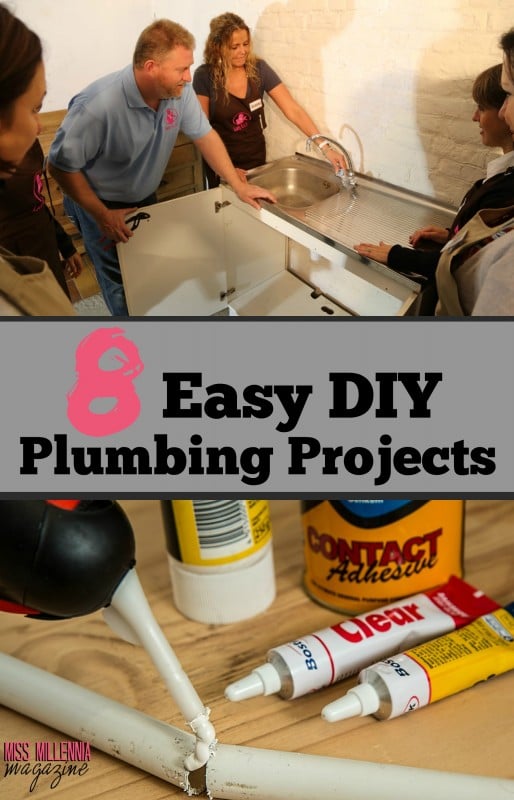8 Easy DIY Plumbing Projects
Homeownership comes with many ups and downs, with plumbing problems being one of the biggest downers. But if you’re willing and able to DIY, you can easily fix some of the most common plumbing issues and save yourself a lot of money on service and labor fees.
Don’t let plumbing projects scare you. If you have an adjustable wrench, slip joint pliers, a screwdriver, access to a hardware store, and the ability to read step by step directions, you can tackle most of the plumbing problems that come along with homeownership.
Here are a few DIY plumbing projects are all fairly simple and almost anyone can complete with a little patience and willingness to get your hands dirty.
1. Recognize a leak
Water leaks are not only wasteful but potentially hazardous. Some homeowners, unaware of hazardous leaks, can end up blindsided by the renovation and repair costs associated with the resulting water damage. Leaks can rot away floor boards, destroy walls, and even compromise the structural integrity of your home. Learning how to check for leaks will help you prevent any unfortunate water damage from occurring.
To see if there are any active leaks, you will need to shut off the water supply to your home. You can do this by locating your water meter box, and turning the water shut-off valve.
Your water meter will most likely be located by the front curb of your house. (If you live in an apartment or condo, you should be able to find your water shut-off valve in your unit’s utility closet.) For a single-family home, the meter box looks like a concrete or metal lid in the ground. Inside the meter box, you will find the water meter, a leak detector, and the water shut-off valve.
The amount of water that is moving through your system will be indicated by the leak detector (a small red triangle that spins). The faster the leak indicator spins, the bigger the leak in your home. If your water is completely shut off and that little triangle is still spinning, you know you have a problem.
Generally, depending on your meter, a full rotation of the red needle on the meter means that one cubic foot of water per minute (more than seven gallons) has passed through the meter.
2. Fix a leaky faucet
If you hear a constant dripping or notice a pool of water under your sink, you definitely have a leak that needs to be fixed. Not only does that leak cost you because you’re paying for the water, but you’re also going to have extensive and costly water damage if you don’t take care of the problem soon.
Luckily, a leaky faucet is a DIY plumbing fix you can finish in under an hour. Here’s how to avoid calling a plumber:
- Turn off your sink’s water supply by turning the valve until the water shuts off. Release the remaining pressure by turning on the faucet.
- Make sure to plug the sink’s drain with a drain plug (or just cover the drain with a rag) to make sure you don’t lose important screws into the p-trap
.
- Remove the handle by taking off the decorative cap and using a screwdriver or Alan wrench to remove the screws holding it in place.
- Disassemble the faucet by removing the housing, screws, and cartridge (notice how you disassemble the cartridge because the new cartridge will need to go in the exact same way it came out).
- After you replace the cartridge, reassemble your faucet’s handle.
- Turn the water back on, and you’re good to go.
Tools you’ll need:
- Wrench
- Screwdriver or Alan wrench set
- A new faucet cartridge
3. Unclog a sink drain
If you notice that your sink is slow to drain, or has stopped draining altogether, you have a few options. A plunger might be enough to push the clog through, but for larger or more persistent clogs, you will need to use a plumbing snake or pour chemicals. You also may be able to fix the clog by simply cleaning out your P-trap. Hair, pasta, corn silk, small vegetables, and other miscellaneous items can easily block up the P-trap over time. The P-trap is the section of pipe directly under your sink shaped like a P (or a U, depending on your angle).
To remove a clog in your P-trap:
- Place a bucket or bowl under the pipe to catch water that’s sitting inside the pipe.
- Unscrew the fitting attached to the sink drain.
- Disconnect the side of the P-trap that leads to the waste pipe.
- Clear out the debris.
- Reattach the P-trap and your sink should be ready to get things flowing again.
Tools you’ll need:
- Depending on how tightly the P-trap is screwed into the sink, you may need a simple wrench to help loosen the section of pipe from under the sink.
- A bucket to catch excess water.
- A rag to mop up any water spill.
4. Install a new shower head
Installing a new shower head is as simple as unscrewing the old shower head and screwing the new one back on. However, when executing this DIY plumbing project, it’s important to remember to protect your shower head pipe with a rag so it doesn’t get crushed or scratched.
Here is how you install a new shower head:
- Unscrew the old shower head by holding a rag over the pipe while loosening the shower head with pliers.
- Once removed, use an old toothbrush to clean out the threads of the shower arm.
- Cover the threads with Teflon tape
or pipe thread to create a good seal on the new shower head.
- Screw the new showerhead on by hand until it fits snugly against the pipe thread tape. Then use your pliers to finish tightening the shower head.
Tools you’ll need:
- Groove joint pliers
- Two rags
- Pipe thread (or Teflon tape)
- New shower head
5. Fix a running toilet
Every time you flush a toilet, pressing down on the handle lifts the flapper valve to allow water to flow from the tank into the toilet bowl. If the seal is faulty, you’re going to have a running toilet (which is not only annoying to listen to but extremely wasteful as well). Most often, you can fix this wasteful problem by simply installing a new flapper (which run for as little as $3.00).
To fix a running toilet:
- Turn off the water supply to the tank (the shut-off valve should be right on the underside of the toilet).
- Drain the water in the tank by flushing the toilet and holding the flapper open to let the water drain out.
- Use a sponge or towel to remove any excess water.
- Install the new flapper adjusting the water height and chain length according to the directions that come with the kit.
6. Replace a faucet
Due to rust from leaks, damage from use over time, or simply a desire for a change in style, faucets need to be replaced from time to time. Instead of hiring a professional and paying their astronomical service fees plus the cost of labor, you should just replace that faucet yourself. It may sound daunting if you have never done a DIY project before, but it’s actually a pretty straightforward process. Not only will you save money by doing it yourself, but you can actually increase your home’s value by updating fixtures.
To replace a faucet:
- Turn off the water at the sink by turning the valve until the water is off. (If there is no shut-off valve for the sink alone, you will have to turn off your entire water supply.)
- Open the faucet to remove any remaining water pressure.
- Remove the sink drain and tailpiece connection at the sink drain.
- Disconnect the drain and P-trap assembly (not a necessary step, but will give you more room to work).
- Once everything is detached, you should be able to lift out the old faucet.
- The first step to replacing the faucet is to place a rubber “o” ring at the faucet base. Then insert the lower end of the faucet into the sinkhole, while slipping on a mounting plate and washer.
- Follow the directions that come with your particular fixture to install the new faucet. Make sure to use plumber’s putty to create a watertight seal at the valve base.
- Once the lines are reconnected, you can then reassemble the drain and P-trap.
- Turn on the water supply and test for leaks by leaving a piece of paper under the pipes for a few minutes. If you don’t see any droplets, you’ll be good to go.
Tools you’ll need:
- A new faucet kit
- Wrench
- Screwdriver
- Plumber’s putty
7. Replace a leaky outdoor water spigot
Leaky water spigots can cost you a ton of money if you let them continue to drip water over time. As long as the valve itself isn’t leaking, you should be able to easily fix or replace the fixture to stop the leaking.
How to stop an outdoor water spigot from leaking:
- Leave the water on. This will help you know how to adjust the spigot.
- Simply use an adjustable wrench to tighten the bolt holding the fixture in place. Sometimes this quick fix will stop the leak.
If a quick tightening of the spigot doesn’t stop the leak, then you may need to replace the hose attachment. Don’t worry, replacing a spigot is just as quick and easy as replacing a showerhead.
How to replace an outdoor water spigot:
- As always, turn off the water supply
- Unscrew the old spigot using a rag to protect the pipe from your tools.
- Use a wrench to loosen the old spigot (hose attachment).
- Clean the grooves of the supply pipe and apply outdoor-friendly pipe thread to make sure the new spigot has a secure and watertight seal.
- Screw the new faucet in by hand, then use a wrench or pliers (protected by a rag) to finish tightening the new outdoor spigot.
Tools you’ll need:
- New outdoor spigot
- Wrench
- Outdoor pipe thread
- Rag
8. Replace a garbage disposal
If your disposal isn’t disposing of waste as it should or you notice food is getting clogged in your drain, it’s time to replace it. No worries, this is another easy DIY plumbing project.
How to replace garbage disposal:
- Turn off the electricity to your kitchen and then disconnect the wires to the disposal.
- Remove the P-trap from the connection at the wall (remember to have a bucket handy to catch debris)
- Next, you will need to disconnect the drain line from the dishwasher to the disposal (you simply need to loosen the hose clamp and the line will slide right off).
- Remove the disposal unit from the drain basket by releasing the mounting collar. (Hold on the disposal because after you loosen the mounting collar it will fall if you’re not supporting it.)
- Your new disposal will come with a new mounting collar. Follow the directions for installation of your new unit by replacing the mounting collar, using plumber’s putty to get an airtight seal, and reconnecting the new unit in reverse order from how you took it out.
- Once the new unit is installed, turn on the electricity and see how your new disposal works.
Tools you’ll need:
- Wrench
- Screwdriver
- Plumber’s putty
- New disposal kit
Don’t be afraid to DIY
Home projects can seem confusing and overwhelming, especially when plumbing is involved. Don’t let the little projects scare you away though. With simple tools, some patience, and the ability to read the directions that come with your replacement parts, DIY plumbing is no more difficult than putting together furniture from IKEA. Save your hard earned money and give DIY plumbing a chance, instead of paying a professional for a fifteen-minute job.
Have you tried any DIY plumbing projects? How much money did you save by doing it yourself?
Invibed is an online destination that makes personal finance relevant, accessible and entertaining to millennials. Follow Invibed on Facebook and Instagram.







